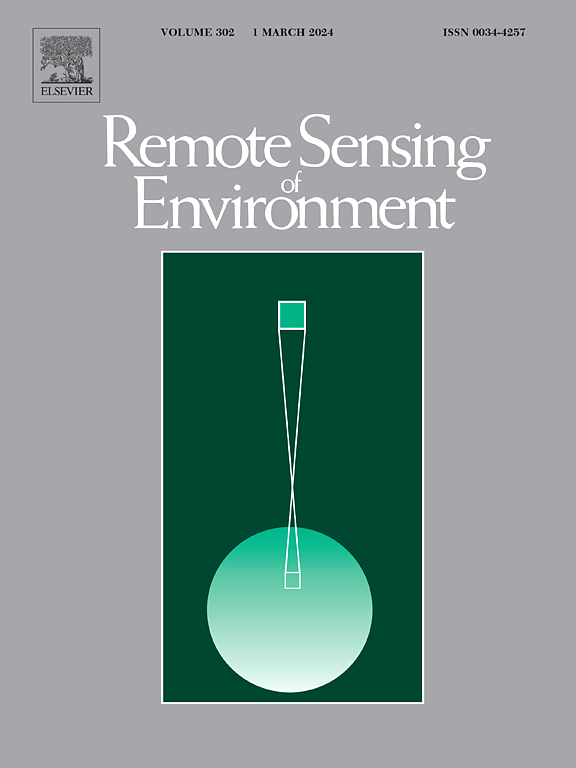Across-scale thermal infrared anisotropy in forests: Insights from a multi-angular laboratory-based approach
IF 11.4
1区 地球科学
Q1 ENVIRONMENTAL SCIENCES
引用次数: 0
Abstract
The Land Surface Temperature (LST) is well suited to monitor biosphere–atmosphere interactions in forests, as it depends on water availability and atmospheric/meteorological conditions above and below the canopy. Satellite-based LST has proven integral in observing evapotranspiration, estimating surface heat fluxes and characterising vegetation properties. Since the radiative regime of forests is complex, driven by canopy structure, components radiation properties and their arrangement, forest radiative temperatures are subject to strong angular effects. However, this depends on the scale of observation, where scattering mechanisms from canopy – to satellite – scales influence anisotropy with varying orders of magnitude. Given the heterogeneous and complex nature of forests, multi-angular data collection is particularly difficult, necessitating instrumentation distant enough from the canopy to obtain significant canopy brightness temperature and concurrent observations to exclude turbulence/atmospheric effects. Accordingly, current research and understanding on forest anisotropy at varying scales (from local validation level to satellite footprint) remain insufficient to provide practical solutions for addressing angular effects for upcoming thermal satellite sensors and associated validation schemes. This study presents a novel method founded in the optical remote sensing domain to explore the use of microcanopies that represent forests at different scales in the footprint of a multi-angular goniometer observing system. Both Geometric Optical (GO) and volumetric scattering dominated canopies are constructed to simulate impacts of anisotropy in heterogeneous and homogeneous canopies, and observed using a thermal infrared radiometer. Results show that heterogeneous canopies dominated by GO scattering are subject to much higher magnitudes of anisotropy, reaching maximum temperature differences of 3 °C off-nadir. Magnitudes of anisotropy are higher in sparse forests, where the gap fraction and crown arrangement (inducing sunlit/shaded portions of soil and vegetation) drive larger off-nadir differences. In dense forests, anisotropy is driven by viewing the maximum portion of sunlit vegetation (hotspot), where the soil is mostly obscured. Canopy structural metrics such as the fractional cover and gap fraction were found to have significant correlation with off-nadir differences. In more homogeneous canopies, anisotropy reaches a lower magnitude with temperature differences up to 1 °C, driven largely by volumetric scattering and components radiation properties. Optimal placement of instrumentation at the canopy-scale (more heterogeneous behaviour due to proximity to the canopy and small pixel size) used to validate satellite observations (more homogeneous behaviour due to larger pixel size) was found to be in cases of viewing maximum sunlit vegetation, for dense canopies. Given upcoming high spatial resolution sensors and associated validation schemes needed to benchmark LST and downstream products such as evapotranspiration, a better understanding of anisotropy over forests is critical to provide accurate, long-term and multi-sensor products.
森林的跨尺度热红外各向异性:来自多角度实验室方法的见解
地表温度(LST)非常适合监测森林中生物圈-大气的相互作用,因为它取决于林冠上下的水分供应和大气/气象条件。基于卫星的地表温度已被证明是观测蒸散发、估算地表热通量和表征植被特性的不可或缺的工具。由于森林的辐射状态是复杂的,受冠层结构、组分辐射特性及其排列的驱动,森林辐射温度受到强烈的角效应的影响。然而,这取决于观测尺度,从冠层尺度到卫星尺度的散射机制以不同的数量级影响各向异性。考虑到森林的异质性和复杂性,多角度数据收集特别困难,需要离冠层足够远的仪器来获得重要的冠层亮度温度和同时观测以排除湍流/大气影响。因此,目前对不同尺度(从局部验证水平到卫星足迹)森林各向异性的研究和理解仍然不足以为即将到来的热卫星传感器和相关验证方案提供解决角度效应的实际解决方案。本研究提出了一种建立在光学遥感领域的新方法,用于探索在多角仪观测系统的足迹中使用代表不同尺度森林的微冠层。构建几何光学(GO)和体积散射主导的冠层来模拟非均质和非均质冠层的各向异性影响,并使用热红外辐射计进行观测。结果表明,以氧化石墨烯散射为主的非均质冠层具有更大的各向异性,最高温差可达3°C。在疏林中,各向异性的大小更高,在疏林中,林隙分数和树冠排列(诱导土壤和植被的阳光/阴影部分)驱动较大的离底差异。在茂密的森林中,各向异性是通过观察日照植被的最大部分(热点)来驱动的,那里的土壤大多被遮蔽。冠层结构指标如覆盖度分数和间隙分数与非最低点差异有显著相关。在更均匀的冠层中,各向异性达到较低的量级,温差高达1°C,主要由体积散射和分量辐射特性驱动。研究发现,在观测最大日照植被的情况下,对于密集的冠层,用于验证卫星观测的仪器在冠层尺度上的最佳放置(由于接近冠层和较小的像元尺寸,其行为更不均匀)(由于较大的像元尺寸,其行为更均匀)。考虑到即将到来的高空间分辨率传感器和相关的验证方案需要对地表温度和蒸散发等下游产品进行基准测试,更好地了解森林的各向异性对于提供准确、长期和多传感器产品至关重要。
本文章由计算机程序翻译,如有差异,请以英文原文为准。
求助全文
约1分钟内获得全文
求助全文
来源期刊

Remote Sensing of Environment
环境科学-成像科学与照相技术
CiteScore
25.10
自引率
8.90%
发文量
455
审稿时长
53 days
期刊介绍:
Remote Sensing of Environment (RSE) serves the Earth observation community by disseminating results on the theory, science, applications, and technology that contribute to advancing the field of remote sensing. With a thoroughly interdisciplinary approach, RSE encompasses terrestrial, oceanic, and atmospheric sensing.
The journal emphasizes biophysical and quantitative approaches to remote sensing at local to global scales, covering a diverse range of applications and techniques.
RSE serves as a vital platform for the exchange of knowledge and advancements in the dynamic field of remote sensing.
 求助内容:
求助内容: 应助结果提醒方式:
应助结果提醒方式:


